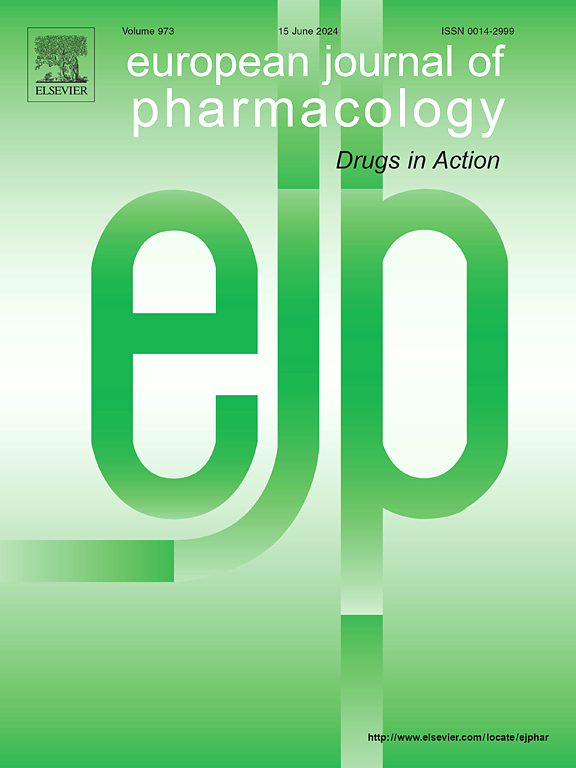木犀草素通过抗炎、抗凋亡和Nrf2/ ho -1介导的抗氧化作用减轻肾缺血再灌注损伤
IF 4.2
3区 医学
Q1 PHARMACOLOGY & PHARMACY
引用次数: 0
摘要
肾缺血/再灌注(I/R)损伤是急性肾损伤(AKI)最常见的原因。它可以通过肾纤维化途径发展为慢性损伤并随后发展为慢性肾脏疾病(CKD)。木犀草素是最常见的类黄酮之一,对多种病理生理过程具有潜在的治疗活性。本研究通过系统网络药理学、分子对接和体内实验研究,探讨木犀草素对肾脏I/R损伤的保护作用及其可能机制。利用网络药理学方法,构建并分析了木犀草素-肾I/R损伤靶点网络。我们通过分子对接分析评估木犀草素与肾I/R损伤靶点之间的关系。随后,我们利用单侧缺血再灌注损伤(UIRI)建立了AKI向CKD过渡的大鼠模型,并利用生化指标检测相关蛋白的表达变化。网络药理分析和分子对接表明木犀草素通过多靶点和多途径影响肾脏I/R损伤。体内实验表明,木犀草素通过调节核因子-红细胞2相关因子2 (Nrf2)/血红素加氧酶-1 (HO-1)通路,抑制大鼠肾脂质过氧化,显著减轻I/ r诱导的肾氧化损伤。木犀草素降低相关炎症标志物水平,显著上调凋亡相关蛋白的合成,下调抗凋亡蛋白的表达。我们的研究结果表明木犀草素能有效抑制肾I/R损伤引起的氧化损伤、炎症、细胞凋亡和纤维化,从而发挥肾保护作用。木犀草素的抗氧化作用可能与调控Nrf2/HO-1信号有关。本文章由计算机程序翻译,如有差异,请以英文原文为准。
Luteolin mitigates renal ischemia-reperfusion injury via anti-inflammatory, anti-apoptotic, and Nrf2/HO-1-mediated antioxidant effects
Renal ischemia/reperfusion (I/R) injury is the most common cause of acute kidney injury (AKI). It can progress to chronic injury and subsequently to chronic kidney disease (CKD) via the renal fibrosis pathway. Luteolin is one of the most commonly occurring flavonoids and exhibits potential therapeutic activity against various pathophysiological processes. In this study, we investigated the protective role of luteolin in counteracting renal I/R injury and its potential mechanisms through systematic network pharmacology, molecular docking, and in vivo experimental studies. Using network pharmacology, we constructed and analyzed a luteolin-renal I/R injury target network. We assessed the relationship between luteolin and renal I/R injury targets using molecular docking analysis. Subsequently, we established a rat model of AKI to CKD transition using unilateral ischemia/reperfusion injury (UIRI), and detected changes in the expression of related proteins using biochemical indices.
Network pharmacological analysis and molecular docking showed that luteolin affected renal I/R injury through multiple targets and pathways. As demonstrated by in vivo experiments, luteolin significantly attenuated renal I/R-induced oxidative injury by inhibiting renal lipid peroxidation in rats through the modulation of the nuclear factor erythroid 2-related factor 2 (Nrf2)/heme oxygenase-1 (HO-1) pathway. Luteolin attenuated the levels of relevant inflammatory markers, significantly upregulated the synthesis of apoptosis-related proteins, and downregulated the expression of anti-apoptotic proteins. Our results suggest that luteolin effectively inhibited oxidative damage, inflammation, apoptosis, and fibrosis caused by renal I/R injury, thus exerting a nephroprotective effect. The antioxidant effects of luteolin may be related to the regulation of Nrf2/HO-1 signaling.
求助全文
通过发布文献求助,成功后即可免费获取论文全文。
去求助
来源期刊
CiteScore
9.00
自引率
0.00%
发文量
572
审稿时长
34 days
期刊介绍:
The European Journal of Pharmacology publishes research papers covering all aspects of experimental pharmacology with focus on the mechanism of action of structurally identified compounds affecting biological systems.
The scope includes:
Behavioural pharmacology
Neuropharmacology and analgesia
Cardiovascular pharmacology
Pulmonary, gastrointestinal and urogenital pharmacology
Endocrine pharmacology
Immunopharmacology and inflammation
Molecular and cellular pharmacology
Regenerative pharmacology
Biologicals and biotherapeutics
Translational pharmacology
Nutriceutical pharmacology.

 求助内容:
求助内容: 应助结果提醒方式:
应助结果提醒方式:


